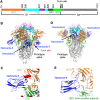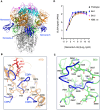Dual-role epitope on SARS-CoV-2 spike enhances and neutralizes viral entry across different variants
- PMID: 39236072
- PMCID: PMC11407660
- DOI: 10.1371/journal.ppat.1012493
Dual-role epitope on SARS-CoV-2 spike enhances and neutralizes viral entry across different variants
Abstract
Grasping the roles of epitopes in viral glycoproteins is essential for unraveling the structure and function of these proteins. Up to now, all identified epitopes have been found to either neutralize, have no effect on, or enhance viral entry into cells. Here, we used nanobodies (single-domain antibodies) as probes to investigate a unique epitope on the SARS-CoV-2 spike protein, located outside the protein's receptor-binding domain. Nanobody binding to this epitope enhances the cell entry of prototypic SARS-CoV-2, while neutralizing the cell entry of SARS-CoV-2 Omicron variant. Moreover, nanobody binding to this epitope promotes both receptor binding activity and post-attachment activity of prototypic spike, explaining the enhanced viral entry. The opposite occurs with Omicron spike, explaining the neutralized viral entry. This study reveals a unique epitope that can both enhance and neutralize viral entry across distinct viral variants, suggesting that epitopes may vary their roles depending on the viral context. Consequently, antibody therapies should be assessed across different viral variants to confirm their efficacy and safety.
Copyright: © 2024 Ye et al. This is an open access article distributed under the terms of the Creative Commons Attribution License, which permits unrestricted use, distribution, and reproduction in any medium, provided the original author and source are credited.
Conflict of interest statement
The University of Minnesota has filed a patent on Nanosota-5, -6, and -7 with F.L., G.Y., F.B., and B.L. as inventors.
Figures






Similar articles
-
Structural Basis for Evasion of New SARS-CoV-2 Variants from the Potent Virus-Neutralizing Nanobody Targeting the S-Protein Receptor-Binding Domain.Biochemistry (Mosc). 2024 Jul;89(7):1260-1272. doi: 10.1134/S0006297924070083. Biochemistry (Mosc). 2024. PMID: 39218023
-
Structural and functional characterization of nanobodies that neutralize Omicron variants of SARS-CoV-2.Open Biol. 2024 Jun;14(6):230252. doi: 10.1098/rsob.230252. Epub 2024 Jun 4. Open Biol. 2024. PMID: 38835241 Free PMC article.
-
Escape from neutralizing antibodies by SARS-CoV-2 spike protein variants.Elife. 2020 Oct 28;9:e61312. doi: 10.7554/eLife.61312. Elife. 2020. PMID: 33112236 Free PMC article.
-
Therapeutic nanobodies against SARS-CoV-2 and other pathogenic human coronaviruses.J Nanobiotechnology. 2024 May 31;22(1):304. doi: 10.1186/s12951-024-02573-7. J Nanobiotechnology. 2024. PMID: 38822339 Free PMC article. Review.
-
Analysis of the molecular mechanism of SARS-CoV-2 antibodies.Biochem Biophys Res Commun. 2021 Aug 20;566:45-52. doi: 10.1016/j.bbrc.2021.06.001. Epub 2021 Jun 5. Biochem Biophys Res Commun. 2021. PMID: 34116356 Free PMC article. Review.
Cited by
-
Cryo-EM structure of Sudan ebolavirus glycoprotein complexed with its human endosomal receptor NPC1.Commun Biol. 2025 Feb 2;8(1):156. doi: 10.1038/s42003-025-07613-y. Commun Biol. 2025. PMID: 39894818 Free PMC article.
-
Discovery of Nanosota-9 as anti-Omicron nanobody therapeutic candidate.PLoS Pathog. 2024 Nov 26;20(11):e1012726. doi: 10.1371/journal.ppat.1012726. eCollection 2024 Nov. PLoS Pathog. 2024. PMID: 39591462 Free PMC article.
-
Discovery of Nanosota-EB1 and -EB2 as Novel Nanobody Inhibitors Against Ebola Virus Infection.PLoS Pathog. 2024 Dec 23;20(12):e1012817. doi: 10.1371/journal.ppat.1012817. eCollection 2024 Dec. PLoS Pathog. 2024. PMID: 39715280 Free PMC article.
References
MeSH terms
Substances
Supplementary concepts
Grants and funding
LinkOut - more resources
Full Text Sources
Medical
Molecular Biology Databases
Miscellaneous

